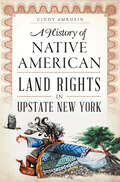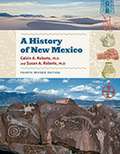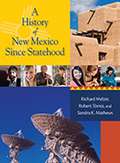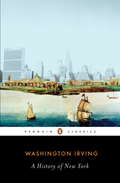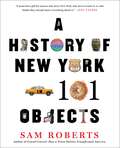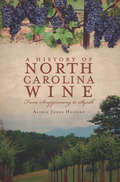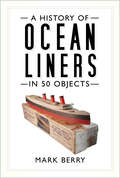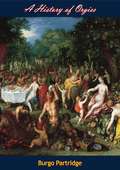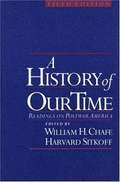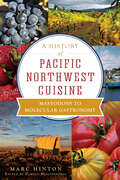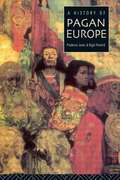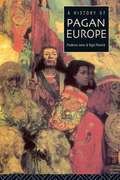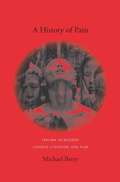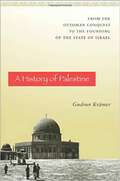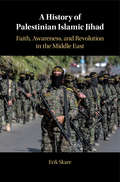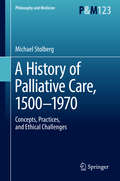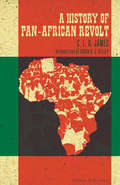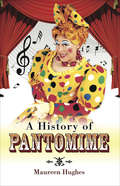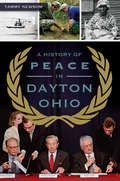- Table View
- List View
A History of Native American Land Rights in Upstate New York
by Cindy AmrheinA complex and troubled history defines the borders of upstate New York beyond the physical boundaries of its rivers and lakes. The United States and the state were often deceptive in their territory negotiations with the Iroquois Six Nations. Amidst the growing quest for more land among settlers and then fledgling Americans, the Indian nations attempted to maintain their autonomy. Yet state land continued to encroach the Six Nations. Local historian Cindy Amrhein takes a close and critical view of these transactions. Evidence of dubious deals, bribes, faulty surveys and coerced signatures may help explain why many of the Nations now feel they were cheated out of their territory.
A History of New Mexico (3rd Revised Edition)
by Susan A. Roberts Calvin A. RobertsMOST OF YOU READING THESE WORDS LIVE in the state of New Mexico. Some of you were born here. Others of you moved here from some other place. As New Mexicans, you already know something about your state. You know most, of course, about the area in which you live. But New Mexico covers a large area. It is a land in which different peoples have developed different ways of living. To learn more about the land and its people, you will need to study the history of New Mexico.
A History of New Mexico (Fourth Edition)
by Susan A. Roberts Calvin A. RobertsThe book presents a comprehensive introduction to geographic features as well as to the social, economic, and political events that have shaped the state's development.
A History of New Mexico Since Statehood
by Sandra K. Mathews Richard Melzer Robert J. TorrezFor the first time, there is now a textbook that addresses state standards for the teaching of New Mexico history at the high school level. In this thoughtful work, the authors delineate New Mexico's role in the shaping of the United States by carefully analyzing how the rich histories of the many cultures of the region affected and in turn were affected by influxes of newcomers seeking health benefits, minerals, farms, relaxation, and new beginnings. Supplementing this richly illustrated and accessible textbook is the optional Teacher Guide Book on CD for use with A History of New Mexico Since Statehood, which will help in structuring lessons, tests, and student activities. The Teacher Guide Book is included free with the purchase of twenty-five classroom copies.
A History of New York
by Washington IrvingPurchase of this book includes free trial access to www. million-books. com where you can read more than a million books for free. This is an OCR edition with typos. Excerpt from book: BOOK I. CONTAINING DIVERS INGENIOUS THEORIES AVD PHILOSOPHIC SPECULATIONS, CONCERNING THE CREATION AND POPULATION OF THE WORLD, AS CONNECTED WITH THE HISTORY OF NEW-YORK. CHAPTER I. Description of the World. According to the best authorities, theworld iu which we dwell is a huge, opaque, reflecting, inanimate mass, floating in the vast ethereal ocean of infinite space. It has the form of an orange, being an oblate spheroid, curiously flattened at opposite parts, for the insertion of two imaginary poles, which are supposed to penetrate and unite at the centre; thus forming an axis on which the mighty orange turns with a regular diurnal revolution. The transitions of light and darkness, whence proceed the alternations of day and night, are produced by this diurnal revolution successively pre- 32 DERSCRIPTION OF THE WORLD. tenting the different parts of the earth to the rays of the sun. The latter is, according to the best, that is to say, the latest accounts, a luminous or fiery body, of a prodigious magnitude, from which this world is driven by a centrifugal or repelling power, and to which it is drawn by a centripetal or attractive force; otherwise called the attraction of gravitation; the combination, or rather the counteraction of these two opposing impulses pBoducing a circular and annual revolution. Hence result the different seasons of the year, viz. spring, summer, autumn, and winter. This I believe to be the most approved modern theory on the subject?though there be many philosophers who have entertained very different opinions; some, too, of them entitled to much deference from their great antiquity and illustrious characters. Thus it was advanced by some of the ancient sages, that the earth was an extended plain, supported by vast pillars; and by . . .
A History of New York in 101 Objects
by Sam Roberts“Delightfully surprising….A portable virtual museum…an entertaining stroll through the history of one of the world’s great cities” (Kirkus Reviews), told through 101 distinctive objects that span the history of New York, almost all reproduced in luscious, full color.Inspired by A History of the World in 100 Objects, Sam Roberts of The New York Times chose fifty objects that embody the narrative of New York for a feature article in the paper. Many more suggestions came from readers, and so Roberts has expanded the list to 101. Here are just a few of what this keepsake volume offers: -The Flushing Remonstrance, a 1657 petition for religious freedom that was a precursor to the First Amendment to the Constitution. -Beads from the African Burial Ground, 1700s. Slavery was legal in New York until 1827, although many free blacks lived in the city. The African Burial Ground closed in 1792 and was only recently rediscovered. -The bagel, early 1900s. The quintessential and undisputed New York food (excepting perhaps the pizza). -The Automat vending machine, 1912. Put a nickel in the slot and get a cup of coffee or a piece of pie. It was the early twentieth century version of fast food. -The “I Love NY” logo designed by Milton Glaser in 1977 for a campaign to increase tourism. Along with Saul Steinberg’s famous New Yorker cover depicting a New Yorker’s view of the world, it was perhaps the most famous and most frequently reproduced graphic symbol of the time. Unique, sometimes whimsical, always important, A History of New York in 101 Objects is a beautiful chronicle of the remarkable history of the Big Apple. “The story [Sam Roberts] is telling is that of New York, and he nails it” (Daily News, New York).
A History of Nigeria
by Toyin Falola Matthew M. HeatonNigeria is Africa's most populous country and the world's eighth largest oil producer, but its success has been undermined in recent decades by ethnic and religious conflict, political instability, rampant official corruption and an ailing economy. Toyin Falola, a leading historian intimately acquainted with the region, and Matthew Heaton, who has worked extensively on African science and culture, combine their expertise to explain the context to Nigeria's recent troubles through an exploration of its pre-colonial and colonial past, and its journey from independence to statehood. By examining key themes such as colonialism, religion, slavery, nationalism and the economy, the authors show how Nigeria's history has been swayed by the vicissitudes of the world around it, and how Nigerians have adapted to meet these challenges. This book offers a unique portrayal of a resilient people living in a country with immense, but unrealized, potential.
A History of North Carolina Wine: From Scuppernong to Syrah (American Palate)
by Alexia Jones HelsleyTake a journey through the long and exciting history of North Carolina grapes and vines. The state's native grapes grew with a wild abandon that uniformly impressed early explorers. Wine production, however, is another story--one with peaks and valleys and switchbacks. Alexia Jones Helsley recounts a tale of promise that was long unfulfilled, of disappointments and success and of competing visions and grapes. These pages speak to those intrigued by the romance of the native muscadines, appreciative of the complex varieties of North Carolina wine and fascinated by the enduring drama of human beings and their dreams. In the Old North State, the highly acclaimed vineyards of today have deep roots in the state's past.
A History of North-Western Europe (Blackwell History of the World)
by Robin BriggsConcentrates solely on North-Western Europe, examines the crucial structural changes that shaped the modern world The History of North-Western Europe provides a broad account of the regions included in the modern states of France, Germany, the Netherlands, Belgium, Austria, and Great Britain. Offering a rigorous yet accessible analytical narrative of the centuries between the fall of the Roman Empire and the First World War, noted historian Robin Briggs examines the many forms of structural change that helped to create a distinctive North-Western European society. Organized chronologically into fourteen substantial chapters, the text covers major events and eras such as the Protestant Reformation, the rise of the fiscal-military state, and the scientific and industrial revolutions that combined to undermine traditional authority structures and generate new understandings of the world. The author also offers insights into the origins and development of the urban and industrial society that ultimately transformed the globe. Topics include the Carolingian dynasty, the rule of feudal lords and popes, the bubonic plague, the Renaissance, the Enlightenment, the Napoleonic wars, the Revolutions of 1848, the growth of nationalism and instability preceding the Great War, and much more. Stimulates readers to reflect in new ways on how the past is crucial to understanding the present Combines a coherent narrative with strong analyses of crucial developments at every stage of North-Western European history Explores the upheavals that shaped the social, religious, economic, and political landscape of the region Discusses how European naval, military, religious, and economic power was projected worldwide The History of North-Western Europe: From Late Antiquity to the First World War is an excellent textbook for undergraduate students in European History courses, as well as a valuable resource for general readers looking for a wide-ranging historical account of the countries of the region.
A History of Ocean Liners in 50 Objects
by Mark BerryExplore the history of ocean liners through the objects that bring them to life.Liners represented the ambitions of their nations in peace and war; their design, interiors and fittings incorporated the finest contemporary technological and artistic features. In peacetime they carried celebrities, vacationers and emigrants; while in war they carried thousands of troops – and then war brides seeking new lives.A History of Ocean Liners in 50 Objects takes in evolving technology, supreme luxury and fine cuisine, as well as hardship and the burning hope for a better life. There is peril, disaster and death, international pride and competition, glory and war. The objects tell a fascinating story, showing how the functional sea voyage has evolved from the late nineteenth and early twentieth century to the huge cruise industry we have today.
A History of Orgies
by Burgo PartridgeAn orgy, the dictionary tells us, is “a wild gathering, marked by promiscuous sexual activity, excessive drinking, etc.” Burgo Partridge tells us precisely what that has meant down through the ages. He begins with the Greeks, who celebrated sexuality at Dionysian festivals, and the Romans, who imported unwholesome brutalities into their orgiastic celebrations. We then learn of the penchant for group sex displayed by medieval popes, the junketings of Restoration England, the aristocratic hedonists of the Hellfire Club and Scotland’s notorious Wig Club, the orgiastic tastes of Casanova and the Marquis de Sade, right into the 20th century and the bizarre excesses of Aleister Crowley.
A History of Ottoman Economic Thought: Developments Before the Nineteenth Century (The Routledge History of Economic Thought)
by Fatih ErmişThe Ottoman Empire (1299-1923) existed at the crossroads of the East and the West. Neither the history of Western Asia, nor that of Eastern Europe, can be fully understood without knowledge of the history of the Ottoman Empire. The question is often raised of whether or not economic thinking can exist in a non-capitalistic society. In the Ottoman Empire, like in all other pre-capitalistic cultures, the economic sphere was an integral part of social life, and elements of Ottoman economic thought can frequently be found in amongst political, social and religious ideas. Ottoman economic thinking cannot, therefore, be analyzed in isolation; analysis of economic thinking can reveal aspects of the entire world view of the Ottomans. Based on extensive archival work, this landmark volume examines Ottoman economic thinking in the classical period using three concepts: humorism, circle of justice and household economy. Basing the research upon the writings of the Ottoman elite and bureaucrats, this book explores Ottoman economic thinking starting from its own dynamics, avoiding the temptation to seek modern economic theories and approaches in the Ottoman milieu.
A History of Our Time: Readings on Postwar America (5th edition)
by William H. Chafe Harvard SitkoffThis popular and comprehensive anthology presents cogent, provocative articles from differing political perspectives on major issues in post-War America.
A History of Our Time: Readings on Postwar America (Third Edition)
by William H. Chafe Harvard SitkoffThis comprehensive, widely-read anthology presents cogent and provocative articles from differing political perspectives on major issues in post-World War II America. The third edition is considerably expanded to include new sections on the origins of the Cold War, the struggle of African-Americans for equality, the feminist movement, and Vietnam. The final section has been completely revised, offering articles on current topics such as the urban underclass, the "greenhouse effect," nuclear arms control, and changing relations with the Soviet Union. In addition to articles by leading historians the editors have chosen first-person accounts by participants in each of the issues under discussion, from Martin Luther King, Jr.'s "Letter from a Birmingham Jail" to Mikhail Gorbechev's historic 1988 speech to the United Nations. With lively introductions to each section providing a context for the articles, this text helps students make sense of the tumultuous world of our time.
A History of Pacific Northwest Cuisine: Mastodons to Molecular Gastronomy (American Palate Ser.)
by Marc HintonWith a dash of humor and a sprinkling of recipes, culinarian Marc Hinton chronicles the bounty of the Pacific Northwest from the mastodon meals of the earliest inhabitants to the gastronomic revolution of today. In this lively narrative, learn how Oregon's and Washington's chefs have used the region's natural abundance to create a sumptuous cuisine that is stylish yet simple and how winemakers and brewers have crafted their own rich beverage traditions. From potlatches to Prohibition, seafood to sustainability and Lewis and Clark to James Beard, Hinton traces the events and influences that have shaped the Pacific Northwest's edible past and created a delectable fare that has foodies and enophiles from around the world clamoring for a taste.
A History of Pagan Europe
by Nigel Pennick Prudence JonesThe book is the definitive study of the indigenous religions of Europe and their practices, beliefs and customs. The authors divide Europe into five broad cultural areas and trace the expression and development of Pagan religion in each of them from earliest times to present day. From the serpent goddesses of ancient Crete to modern nature worship and the restoration of the indigenous religions of Eastern Europe, the wide-ranging book offers a provocative new perspective of European history.
A History of Pagan Europe
by Nigel Pennick Prudence JonesThe first comprehensive study of its kind, this fully illustrated book establishes Paganism as a persistent force in European history with a profound influence on modern thinking. From the serpent goddesses of ancient Crete to modern nature-worship and the restoration of the indigenous religions of eastern Europe, this wide-ranging book offers a rewarding new perspective of European history. In this definitive study, Prudence Jones and Nigel Pennick draw together the fragmented sources of Europe's native religions and establish the coherence and continuity of the Pagan world vision. Exploring Paganism as it developed from the ancient world through the Celtic and Germanic periods, the authors finally appraise modern Paganism and its apparent causes as well as addressing feminist spirituality, the heritage movement, nature-worship and `deep' ecology This innovative and comprehensive history of European Paganism will provide a stimulating, reliable guide to this popular dimension of religious culture for the academic and the general reader alike.
A History of Pain
by Michael BerryThe portrayal of historical atrocity in fiction, film, and popular culture can reveal much about the function of individual memory and the shifting status of national identity. In the context of Chinese culture, films such as Hou Hsiao-hsien's City of Sadness and Lou Ye's Summer Palace and novels such as Ye Zhaoyan's Nanjing 1937: A Love Story and Wang Xiaobo's The Golden Age collectively reimagine past horrors and give rise to new historical narratives.Michael Berry takes an innovative look at the representation of six specific historical traumas in modern Chinese history: the Musha Incident (1930); the Rape of Nanjing (1937-38); the February 28 Incident (1947); the Cultural Revolution (1966-76); Tiananmen Square (1989); and the Handover of Hong Kong (1997). He identifies two primary modes of restaging historical violence: centripetal trauma, or violence inflicted from the outside that inspires a reexamination of the Chinese nation, and centrifugal trauma, which, originating from within, inspires traumatic narratives that are projected out onto a transnational vision of global dreams and, sometimes, nightmares.These modes allow Berry to connect portrayals of mass violence to ideas of modernity and the nation. He also illuminates the relationship between historical atrocity on a national scale and the pain experienced by the individual; the function of film and literature as historical testimony; the intersection between politics and art, history and memory; and the particular advantages of modern media, which have found new means of narrating the burden of historical violence.As Chinese artists began to probe previously taboo aspects of their nation's history in the final decades of the twentieth century, they created texts that prefigured, echoed, or subverted social, political, and cultural trends. A History of Pain acknowledges the far-reaching influence of this art and addresses its profound role in shaping the public imagination and conception-as well as misconception-of modern Chinese history.
A History of Pain: Trauma in Modern Chinese Literature and Film (Global Chinese Culture)
by Michael BerryThe portrayal of historical atrocity in fiction, film, and popular culture can reveal much about the function of individual memory and the shifting status of national identity. In the context of Chinese culture, films such as Hou Hsiao-hsien's City of Sadness and Lou Ye's Summer Palace and novels such as Ye Zhaoyan's Nanjing 1937: A Love Story and Wang Xiaobo's The Golden Age collectively reimagine past horrors and give rise to new historical narratives.Michael Berry takes an innovative look at the representation of six specific historical traumas in modern Chinese history: the Musha Incident (1930); the Rape of Nanjing (1937-38); the February 28 Incident (1947); the Cultural Revolution (1966-76); Tiananmen Square (1989); and the Handover of Hong Kong (1997). He identifies two primary modes of restaging historical violence: centripetal trauma, or violence inflicted from the outside that inspires a reexamination of the Chinese nation, and centrifugal trauma, which, originating from within, inspires traumatic narratives that are projected out onto a transnational vision of global dreams and, sometimes, nightmares. These modes allow Berry to connect portrayals of mass violence to ideas of modernity and the nation. He also illuminates the relationship between historical atrocity on a national scale and the pain experienced by the individual; the function of film and literature as historical testimony; the intersection between politics and art, history and memory; and the particular advantages of modern media, which have found new means of narrating the burden of historical violence. As Chinese artists began to probe previously taboo aspects of their nation's history in the final decades of the twentieth century, they created texts that prefigured, echoed, or subverted social, political, and cultural trends. A History of Pain acknowledges the far-reaching influence of this art and addresses its profound role in shaping the public imagination and conception-as well as misconception-of modern Chinese history.
A History of Palestine: From the Ottoman Conquest to the Founding of the State of Israel
by Graham Harman Gudrun KramerIt is impossible to understand Palestine today without a careful reading of its distant and recent past. But until now there has been no single volume in English that tells the history of the events--from the Ottoman Empire to the mid-twentieth century--that shaped modern Palestine. The first book of its kind, A History of Palestine offers a richly detailed interpretation of this critical region's evolution. <p><p> Starting with the prebiblical and biblical roots of Palestine, noted historian Gudrun Krämer examines the meanings ascribed to the land in the Jewish, Christian, and Muslim traditions. Paying special attention to social and economic factors, she examines the gradual transformation of Palestine, following the history of the region through the Egyptian occupation of the mid-nineteenth century, the Ottoman reform era, and the British Mandate up to the founding of Israel in 1948. <p><p> Focusing on the interactions of Arabs and Jews, A History of Palestine tells how these connections affected the cultural and political evolution of each community and Palestine as a whole.
A History of Palestinian Islamic Jihad: Faith, Awareness, and Revolution in the Middle East
by Erik SkarePalestinian Islamic Jihad (PIJ) is one of the most important yet least understood Palestinian armed factions, both in terms of its history and ideology. Labelled a terrorist organization by the US and the EU, it has grown to become the second largest armed movement in the Gaza Strip and the third largest in the Occupied Palestinian Territories. Using a wealth of primary sources, this book traces the history of PIJ from its origins in the early 1980s to today. By looking at how the group was established, how it has developed in theory and practice, and how it understands religion and politics, Skare seeks to answer the key question of why the PIJ still exist despite the presence of its more powerful sister movement Hamas. In doing so, he fills an important empirical gap in the literature on Palestinian Islamism.
A History of Palliative Care, 1500-1970: Concepts, Practices, and Ethical challenges (Philosophy and Medicine #123)
by Michael StolbergThis book on the history of palliative care, 1500-1970 traces the historical roots of modern palliative care in Europe to the rise of the hospice movement in the 1960s. The author discusses largely forgotten premodern concepts like cura palliativa and euthanasia medica and describes, how patients and physicians experienced and dealt with terminal illness. He traces the origins of hospitals for incurable and dying patients and follows the long history of ethical debates on issues like truth-telling and the intentional shortening of the dying patients' lives and the controversies they sparked between physicians and patients. An eye opener for anyone interested in the history of ethical decision making regarding terminal care of critically ill patients.
A History of Pan-African Revolt (The Charles H. Kerr Library)
by Robin D. G. Kelley C. L. R. JamesOriginally published in England in 1938 and expanded in 1969, this work remains the classic account of global Black resistance. This concise, accessible history of revolts by African peoples worldwide explores the wide range of methods used by Africans to resist oppression and the negative effects of imperialism and colonization as viewed in the 20th century. Written from a radical perspective with a substantial new introduction that contextualizes the work in the ferment of the times, A History of Pan-African Revolt is essential to understanding liberation movements in Africa and the diaspora and continues to reveal new insights, lessons, and visions to successive generations.
A History of Pantomime
by Maureen HughesEach Christmas entire families in the UK troop off to see, what one could almost say is 'the obligatory'. annual entertainment, known as Pantomime. It is a traditional, seasonal way of life for the British envied the world over, and one which only the British seem to understand! Pantomime serves both to entertain and to introduce each new generation to the joys of theatre in the most unique of ways, for this is not a type of theatre one merely watches, but one in which the audience participate often in the most seemingly boisterous and bizarre of ways. The whole experience is steeped in tradition, traditions which only the British seem to understand, which is probably why we are proud to call it a 'British Experience.'In A History of Pantomime Maureen Hughes takes a brief look at the history of Pantomime as well as taking a humorous look at some of the above mentioned traditions; she also gives a synopsis of each of the well-known Pantomimes whilst exploring the eccentric world of the characters who appear in them. There is also a short piece on just some of the most well-known and loved of the actors who each Christmas take on the part of Pantomime Dames across the UK, as well as a look at others who have contributed to this magical world of fun and eccentricity. It is thought by some to be frivolous and pointless piece of theatre, but a browse through this informative book and you will soon find that Pantomime is an art form all of its own, requiring the most dedicated and talented of actors/actresses who are prepared to honour and perpetuate this wonderful tradition as it is passed down from one generation to the next.As seen in The Telegraph and the Sunday Post (Glasgow).
A History of Peace in Dayton, Ohio
by Tammy NewsomWhile the Gem City is better known as the birthplace of aviation, Dayton has an impressive history of working toward peace. Generations of Daytonians worked passionately to create a nonviolent and welcoming community to inspire others. Abolitionists assisted escaped slaves from one Underground checkpoint to the next. Quakers peacefully abstained from war and chartered several colleges in the Dayton area. The Wright brothers invented the airplane to end all wars, and the landmark Dayton Peace Accords famously ended the war in Bosnia and Herzegovina. Author Tammy Newsom explores the inventiveness, compassion and courage of the men and women who have made Dayton a city of peace.
